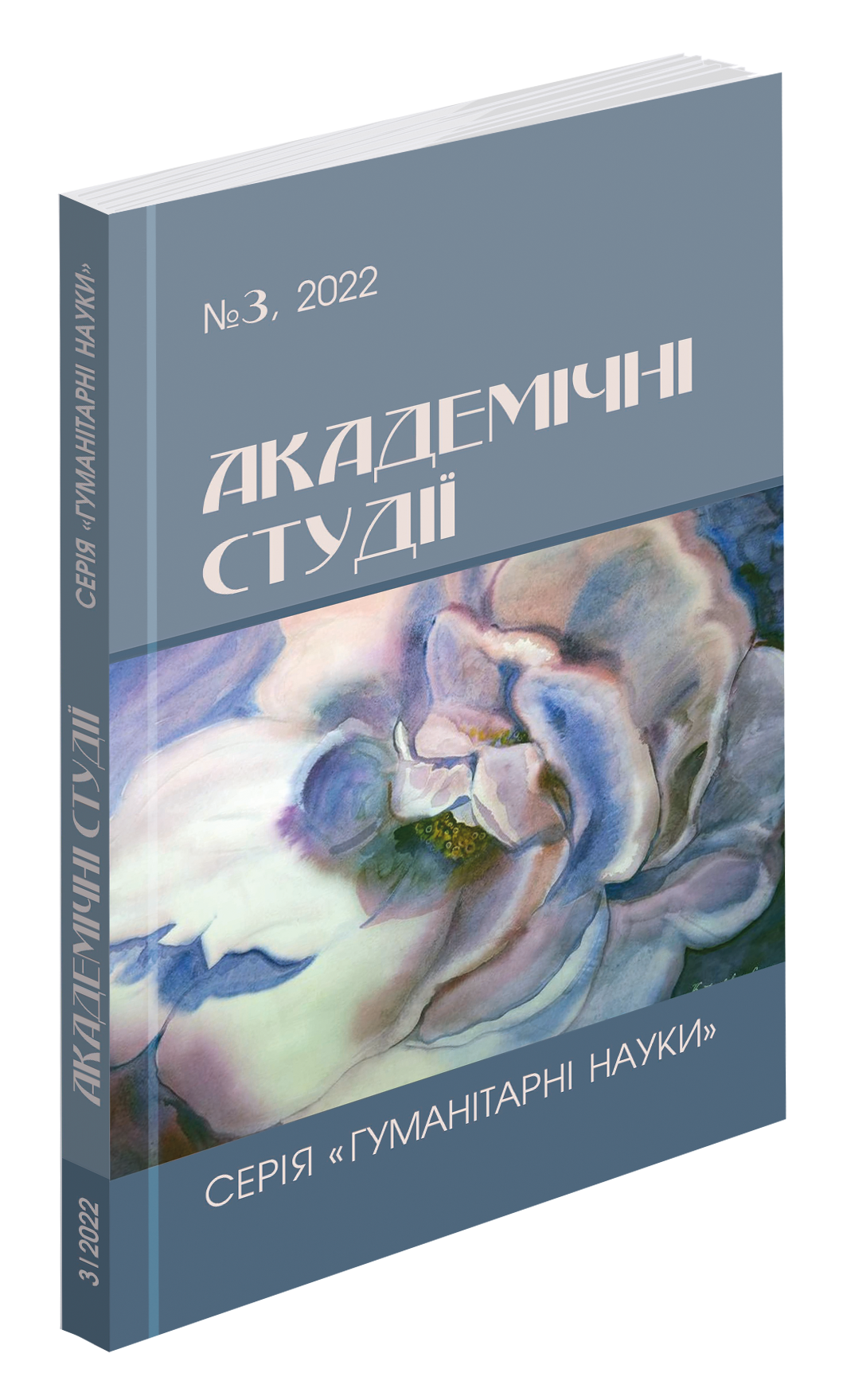Abstract
The article is devoted to archetypal images in the novel of the modern Ukrainian writer S. Zhadan. The scientist identified and analyzed various variations and projections of archetypes, characterized the features of the most significant and important ones. In particular, it is noted that the writer revealed several archetypes in the text, which can be grouped as spatial-energy, time-space, zoomorphic and plant. Among the first, the researcher proposes to include the archetype of the House-dwelling, a dwelling with the ancestral memory of several generations, and its variations of the House as a temporary shelter – these are the locations of the train station and the boarding school building. They can be considered a somewhat binary opposition, that is, "non-House" to the archetype of a stable House. Among the temporal and spatial ones, the author examines the toponym of the road, and also analyzes through two projections – the physical path of the hero and his inner-metaphysical path of self-discovery and character evolution. The author of the article also draws attention to the fact that the state of crisis and dichotomy, the existential amnesia of the characters is also reflected in the zoomorphic plane through the images of animals, in particular, a dog/dogs/puppies. These images are transformed in the same way: to the primary interpretations as an archetype of the spirit, they acquire the additional functions of assistant animals, whose behavior and consciousness are consistent with the heroes of the novel. Plant images also change in the work, in particular, the sunflower from the traditional symbol of the sun, work and prosperity, strength and well-being acquires the meaning of loss of moral and value orientations and the meaning of being, uselessness, futility of hopes and hopes. Through the prism of modifications of the archetypes presented in the work, the researcher also analyzed the behavior patterns of the characters, revealing their characters. As a result, the idea is postulated that the archetype of the Home in the novel is not just through and through, but the main one, it also acts as a kind of framing of the work: the plot revolves around it, and finding one’s true Home – a physical residence and an inner metaphysical one – is the main goal of the novel’s heroes. Because only such a return is the guarantee of the healing of society and its successful future.
References
Андрусів С. Модус національної ідентичності : Львівський текст 30-х років ХХ ст. Тернопіль : Джура, 2000. 340 с.
Архетип. Літературознавчий словник-довідник Упоряд. : Р.Т. Гром’як, Ю.І. Ковалів та ін. Київ : ВЦ «Академія», 1997. С. 65.
Бахтин М. Формы времени и хронотопа в романе. Очерки по исторической поэтике. Вопросы литературы и эстетики. Москва. Художественная лититература, 1957. 504 с.
Башляр Г. Избранное : поэтика пространства. URL: https://platona.net/load/knigi_po_filosofii/psikhologija/ bashljar_g_izbrannoe_poehtika_prostranstva_per_s_franc/22-1-0-784 (дата звертання: 22.10.22).
Воздвиженський К. «Інтернат» : війна тхне мокрою псятиною. Новий роман нарешті дорослого Жадана. URL: http://texty.org.ua/pg/article/editorial/read/79859/Internat_vijna_tkhne_mokroju_psatynoju_Novyj_roman (дата звертання: 12.08.22).
Войтович В. Українська міфологія. Київ : Либідь, 2002. 664 с.
Герасименко Н. Архетип дому в романі С.Жадана «Інтернат». Академічні студії. Серія «Гуманітарні науки». Луцьк, 2022. № 1. С. 9-16.
Головченко Н. Про «відмороженого» Пашу Сергія Жадана. Буквоїд. 24 травня. URL: http://bukvoid.com.ua/ reviews/books/2018/05/24/072033.html (дата звертання: 03.08.22).
Гундорова Т. Післячорнобильська бібліотека. Український літературний постмодернізм. Київ : Критика, 2013. 344 с. (Серія «Критичні студії»).
Жадан С. Інтернат. Роман. Чернівці : видавництво «Меридіан Черновіц», 2017. 336 с.
Климова С. Социально-философские аспекты анализа архитипических функций дома. URL: http:// anthropology.ru/ru/texts/klimova/function.html (дата звертання: 20.10.22)
Коваленко О. Мотиви дороги (рух і процесуальність) у поезії Сергія Жадана (на матеріалі збірки «Цитатник»). Патологічна потреба дороги у поезії Сергія Жадана (на матеріалі збірки «Цитатник»). Мॳстеріум. 2010. Вип. 38. С. 90–93.
Кримський С. Архетипи української ментальності. Попович М.В., Кисляковська Ю.В., Вяткіна Н.Б., Навроцький В.В. Проблеми теорії ментальності. Київ : Наукова думка, 2006. С. 285.
Кулінська Я. «Сіра зона» як маркер громадянства (на матеріалі романів С. Жадана «Інтернат» та А. Куркова «Сірі бджоли»). Вісник Харківського національного університету імені В. Н. Каразіна. Серія «Філологія». URL: https://periodicals.karazin.ua/philology/article/view/16388 (дата звертання: 22.10.22).
Лілік О. Архетип Дому в ліриці Григорія Чубая. Сіверянський літопис. 2021. № 1. С. 162–168.
Лотман Ю. Семиосфера : культура и взрыв. Внутри мыслящих миров. Статьи. Исследования. Заметки. Санкт-Петербург : Искусство, 2000. 704 с.
Михайлишин І. Танець смерті. Щоденник добровольця батальйону «Донбас». Харків : Фоліо, 2020. 315 с. (Воєнні щоденники). 18. Поліщук Я. Донбас як інтернат. URL: http://bukvoid.com.ua/reviews/books/2018/01/01/093332.html (дата звертання: 22.10.22).
Стасіневич Є. «Інтернат» Жадана : дорога до тихого дому. URL: https://archive.chytomo.com/news/internatzhadana- doroga-do-tixogo-domu (дата звертання: 25.10.22).
Тиховська О. Мотив духа в чарівних казках Закарпаття. Науковий вісник Ужгородського університету. Серія: Філологія. 2007. Вип. 15. С. 54–58.
Топоров В. Пространство и текст. Текст : семантика и структура. URL: http://ec-dejavu.ru/p/Publ_Toporov_ Space.html (дата звертання: 21.10.22).
Федорів У. Мотив (без)домності в романі Сергія Жадана «Інтернат». Studia methodologica. 2019. No. 49. URL: http://dspace.tnpu.edu.ua/bitstream/123456789/15433/1/FEDORIV.pdf (дата звертання: 26.10.22).
Урись Т. Архетип як естетична домінанта художнього вираження модусу національної ідентичності в сучасній українській поезії. Науковий вісник Ужгородського університету. Серія: Філологія. 2016. Вип. 1 (35). С. 96-100.
Шутова Е. Архетипы «дом» и «бездомье» и их объективация в духовной культуре. URL: https://cheloveknauka. com/arhetipy-dom-i-bezdomie-i-ih-obektivatsiya-v-duhovnoy-kulture (дата звертання: 21.10.22).
Юнг К.-Г. Душа и миф. Шесть архетипов. Москва : АСТ, Минск : Харвест, 2005. 400 с.

